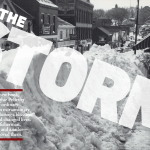The Three Most-Asked Questions About New England
Welcome to the December 2007 edition of “Jud’s New England Journal,” the rather curious monthly musings of Judson Hale, editor-in-chief of Yankee Magazine, published for over 70 years in Dublin, NH. The Three Most-Asked Questions About New England 1. Where’s ‘Down East’ begin? 2. Why were bridges covered? 3. Were spring dance floors built to […]
Welcome to the December 2007 edition of “Jud’s New England Journal,” the rather curious monthly musings of Judson Hale, editor-in-chief of Yankee Magazine, published for over 70 years in Dublin, NH.
The Three Most-Asked Questions About New England
1. Where’s ‘Down East’ begin?
2. Why were bridges covered?
3. Were spring dance floors built to be that way?
I thought by now everyone knew the answers to these. But during this past year, I’ve received quite a few e-mails indicating that quite a few don’t. So, well, for a little Christmas present to those in doubt, here’s my take on all three.
Let’s start with “Down East.” Almost everyone knows the correct meaning in a nautical sense: When you’re sailing northeast along the coast of Maine, you’re almost always sailing with the wind, or downwind. Okay — but where exactly does the area called “Down East” begin?
Many equate the term with the entire coast of Maine. They maintain that it begins the second you cross the Piscataqua Bridge at Portsmouth, New Hampshire, heading north. However, the majority of New Englanders, myself included, think of Portland, Maine, as the very southernmost town or city Down East. Some purists argue that Camden or even Penobscot Bay is the starting point, but I’d call that area “way Down East”. Then, of course, Nova Scotia would become “way, way, way Down East.”
Now as to why bridges were covered and why some of the roofs were so high, I think I’ll refer to my late friend, Joe Allen of Vineyard Haven, Massachusetts. He used to answer reader questions in Yankee under the heading “Sayings of the Oracle.” Here, written a month before he died, is his last reply to the covered bridge question. Obviously, he was sick of the subject. It’s heretofore unpublished, because at the time we felt Joe was being overly cranky. Which he was. But here it is, verbatim.
“Jesus for Guard Almighty, we thought all hands knew by this time. Bridges were covered, damn fool, for the same reason women used to wear petticoats — to protect their underpinnings. Ever hear that wood rots when it gets wet? Your asinine suggestion that they were covered to keep snow off the road is dead wrong. In fact, I recollect throwing snow inside covered bridges after a snowstorm so our sleighs wouldn’t grind on the wood. As to the height of covered bridges, any simpleton would know it took some height to get a full hay wagon through.” Thanks, Joe.
Finally comes the question of spring dance floors. Were they made “springy” deliberately, or were they just the result of weak construction? Well, I had a conversation with Philip Baker of Antrim, New Hampshire, some years ago on this subject. Phil, a noted expert on historic-building restoration, had personally studied spring dance floor construction details during some of his company’s projects. His conclusion: Some were made deliberately and some were that way by accident.
He said the actual springing quality was created by the lack of support beneath the ballroom floor and/or the use of particularly springy timbers for the floor joists. He told me that the Jones Tavern in Weston, Massachusetts, had one of the very best spring dance floors, but like so many of them, it didn’t conform to present-day legal specifications and had to be reinforced, which removed the spring. The original Jones Tavern floor joists were made of 3×10-inch spruce — “a real whippy wood,” Phil said. Certainly that had to be deliberate. Phil and his fellow workers were amazed at how easily they could make the floor “pick up a lively rhythm.”
I’ve walked and bounced (I’m not much of a dancer) across the ballroom of the historic Hamilton House on 9 Chestnut Street in Salem, Massachusetts, and I’m convinced that the considerable spring of that floor in such an otherwise solidly constructed house was no accident.
Maybe next month I’ll address a few more often-asked questions. In the meantime, however, Merry Christmas, everyone.







